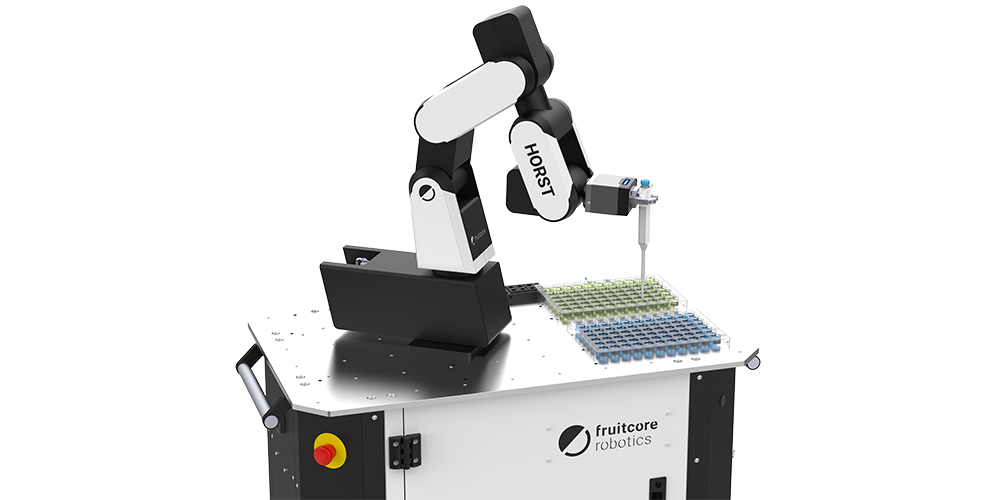5 min read
5 laboratory processes you can automate now – and why
 Benjamin Brumm
:
May 9, 2025 12:44:18 PM
Benjamin Brumm
:
May 9, 2025 12:44:18 PM

Whether in medical diagnostics, research or quality assurance laboratories, the demand for sample processing and the requirements for precision and speed are constantly increasing. However, when manual routine tasks such as pipetting or sorting take up a lot of time, this leads to stress and monotony among laboratory staff. It also hinders the potential productivity of laboratories. In this article, we explain which typical tasks robots can already automate in laboratories today—and what specific advantages this brings.
 1. Sample preparation and pipetting
1. Sample preparation and pipetting
What is it about?
Sample preparation is one of the most labor-intensive and time-consuming tasks in the laboratory. Manual pipetting is not only prone to errors, but also physically demanding for employees. In addition, it requires a great deal of concentration to always pipette the correct amount and avoid contamination.
Why automate?
- Höhere Präzision und Reproduzierbarkeit: Ein Roboter wiederholt jeden Schritt exakt gleich und vermeidet menschliche Fehler durch Ermüdung oder Unachtsamkeit.
- Reduced workload for staff: Instead of spending hours at the pipette, the laboratory team can apply their expertise to more value-adding areas, such as interpreting analysis results. Automating simpler and repetitive tasks in particular also saves on personnel costs.
- Time and cost savings: With the support of robots, samples can be processed autonomously over longer periods of time without human intervention. Processing times are also reduced without compromising quality.
Practical example
6-axis industrial robots, such as HORST robot systems, can be equipped with sensitive gripping systems suitable for laboratory use to dose reagents with high precision. With appropriately equipped software, the pipetting setup can be intuitively defined graphically and quickly and easily adapted to new methods or protocols.
 2. Sample logistics and sorting
2. Sample logistics and sorting
What is it about?
In the daily routine of clinical laboratories or service laboratories in particular, large numbers of sample tubes accumulate, which must be scanned, verified, and distributed to various analysis devices. Archiving—for example, in refrigerators or deep-freeze systems—also ties up capacity.
Why automate?
- Filling gaps during peak periods: Samples usually arrive at laboratories at certain peak times, e.g., at midday after being taken in hospitals or doctors' offices in the morning, and then need to be analyzed quickly. This results in peak periods of a few hours during which it is difficult to find suitable personnel. To avoid having to assign highly qualified and highly paid specialists to simple tasks, a robot can “step in” at a much lower cost.
- Faster turnaround times: A robot arm with a built-in camera can continuously sort sample tubes, scan barcodes, and divide the samples appropriately.
- Fewer errors and mix-ups: Seamless data capture (e.g. via scanners) drastically reduces sorting errors.
- Night operation possible: Unlike purely manual sorting, which would require a night shift, a robot system can continue working in a “ghost shift” without personnel.
Practical example
Several laboratory networks in Europe are already using robotic solutions for sample logistics that sort several hundred tubes per hour. The robots can be stationed on a mobile platform so that they can be positioned at the sampling location and quickly moved as needed—for example, from sorting to machine loading.
 3. Feeding analysis devices
3. Feeding analysis devices
What is it about?
Devices such as centrifuges, PCR systems, spectrometers, and chromatographic analysis units are semi-automated, but usually require manual feeding and removal. As a result, expensive equipment remains partially unused between processing steps.
Why automate?
- Optimal utilization of equipment: A robot can load and remove samples around the clock. This means that every minute is used.
- Consistent process quality: The movements for gripping and positioning the samples can be defined in advance so that they are loaded and unloaded reliably and with repeat accuracy. This minimizes damage to sensitive sample vessels.
- Flexible setup: Modern automation solutions can also be installed in cramped laboratory spaces. The particularly compact HORST600 version, for example, only requires a 230V connection and can be operated safely even in confined spaces with a protective fence or laser monitoring.
Practical example
In a diagnostic center, a robot with dual grippers can remove samples from racks around the clock, insert them into an analysis device, and then place the processed tubes in a separate tray for archiving. Laboratory staff only need to check the results instead of performing repetitive loading tasks.
 4. Sample archiving and warehouse management
4. Sample archiving and warehouse management
What is it about?
Depending on the industry, samples and reference samples are sometimes stored for months or even years. Sorting them into storage racks or locating individual samples for later analysis often involves a huge amount of administrative work.
Why automate?
- Fast, error-free storage and retrieval: A robot picks up archived samples with high precision. Data linking (barcode and laboratory IT) enables it to navigate to the correct position without personnel having to search in cold rooms or freezers.
- Reduced physical strain: The team no longer has to carry heavy archive boxes. This improves working conditions, especially when working in low-temperature units.
- Greater clarity through digital networking: The software automatically logs every item that is stored or retrieved. For audits or queries, it is immediately clear where each sample tube is located.
Practical example
Laboratories often implement a combination of robot applications and automatic storage systems (e.g., deep-freeze or refrigerator modules). Robot software that is open to many systems for interface communication helps here, so that every movement can be documented. Innovative software solutions such as horstOS also leverage the advantages of artificial intelligence and the Internet of Things. For example, the software can be configured to proactively notify users when certain samples need to be brought to the surface.
 5. Documentation and quality control
5. Documentation and quality control
What is it about?
Many laboratories still use manual documentation—for example, when checking fill levels, calibrating pipettes, or recording test results. This ties up staff and is prone to errors. That is why reliable traceability is such an important issue for laboratory operations and basically affects all processing steps.
Why automate?
- Seamless data acquisition: Traceability is particularly important when a sample passes through several stages within a laboratory. If unexpected results occur, it must be possible to determine as quickly as possible how they came about. A fully automated process in which every action performed by the robot is documented makes this much easier than when manual steps are performed one after the other.
- Prevention of human error: Regulatory requirements regarding traceability are becoming increasingly stringent, and with them the demands for precision in laboratories are rising. However, human error (e.g., in labeling or through contamination) can never be completely ruled out. Automation, on the other hand, ensures uniform documentation of all processes and provides reliable and easily retrievable records—without the need for human intervention.
- Real-time feedback: If deviations such as low fill levels are detected, the system can issue a warning message and interrupt the process if necessary.
- No redundant manual work: Employees focus on interpreting data instead of spending their valuable time filling out forms or manually checking inventory.
Practical example
An industrial robot with an integrated camera travels between sampling stations, films/scans fill levels or color changes, and automatically transmits the measured values to the laboratory software. A central control system can be used for safety purposes, stopping the process in the event of discrepancies and alerting personnel at the same time – without any loss of time.
Conclusion: Benefit quickly, grow flexibly
These five examples show that significant gains in efficiency, quality, and time can be achieved simply by automating individual laboratory processes. Those who opt for a modular approach—based, for example, on the easy-to-use HORST industrial robot—can even start small and expand step by step. This allows you to benefit immediately from shorter throughput times and lower error rates without having to invest time and money in special systems.
The advantage
- Relieve your teams of physically demanding or monotonous tasks
- Round-the-clock operation for time-critical situations or during peak periods
- Future-proof thanks to retrofittable system components and software updates
- Fast return on investment thanks to low acquisition and maintenance costs
Investing in a robotics solution now will make your laboratory fit for the ever-increasing demands on speed, quality, and cost-effectiveness—and create ideal conditions for reducing the workload on skilled personnel and improving the quality of results.
Curious?
We would be happy to advise you personally on which process in your laboratory offers the greatest potential for automation. This will enable you to start automating your samples, devices, and documentation with robot support in no time at all—step by step, tailored to your individual requirements.
/Werbebilder%20Fruitcore-Mitarbeiter/fruitcore-robotics-free-trial-kontakt.webp?width=1065&height=1024&name=fruitcore-robotics-free-trial-kontakt.webp)
